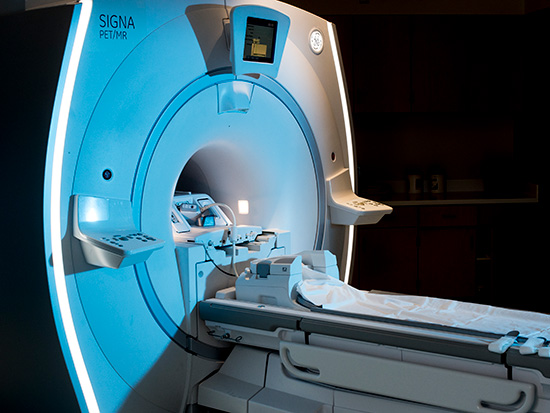 Photography: Steve WoodContrast radiography is a medical method of studying organs utilizing X-rays, CT, MRI, etc. by administering a special dye to help enhance the clarity of the medical examination’s imaging. With the help of the dye, radiologists can evaluate structures with greater clarity, which can increase the sensitivity of the exams, often giving more detailed information to the physicians and physician assistants.
Photography: Steve WoodContrast radiography is a medical method of studying organs utilizing X-rays, CT, MRI, etc. by administering a special dye to help enhance the clarity of the medical examination’s imaging. With the help of the dye, radiologists can evaluate structures with greater clarity, which can increase the sensitivity of the exams, often giving more detailed information to the physicians and physician assistants.
Mason Frazier, M.D., associate professor in the University of Alabama at Birmingham’s Marnix E. Heersink School of Medicine’s Department of Radiology, says contrast imaging is important part of medical imaging because it is used evaluate, diagnose, and treat many routine and more critical conditions, to include stroke, acute coronary syndrome, and trauma.
“UAB Hospital is the only Level I Trauma Center verified by the American College of Surgeons in the state of Alabama and is a major treatment center in the southeastern United States for patients suffering traumatic injury,” Frazier said. “Contrasted exams are a vital part of the evaluation process that helps guide management and treatment.”
An example would be the heart catheterization process. During this type of exam, a physician injects contrast dye into the IV and evaluates the enhanced vessels, as the contrast passes through the heart and into the coronary arteries, to determine whether the flow is normal or if there is blockage.
“Sometimes contrast enhanced imaging serves as a helpful supplement to clinical reasoning, but we could get to the same diagnosis using other modalities,” said Kierstin Kennedy, M.D., interim chief medical officer at UAB Hospital. “In other cases, using contrasted studies is the only viable option, like performing heart catheterizations. Our goal is to preserve our contrast for the clinical scenarios like these where there is no reasonable alternative.”
COVID-19 shutdowns in Shanghai, China, have caused a significant global shortage of intravenous contrast used in imaging procedures. UAB Health System has activated a response to aggressively ration supplies of IV contrast to mitigate the threat. Learn more here.
At UAB, over 2,500 contrast imaging exams are performed on a weekly basis. In addition, UAB is a certified Comprehensive Stroke Center that evaluates and treats patients with acute and complex strokes.
“As a result, we handle more than 1,800 stroke cases annually,” Frazier said. “CT and CT angiograms using IV contrast are key to early stroke diagnosis, and IV contrast is also used to help guide stroke intervention.”
Alternative tests and exams include non-contrast CT exams, MRIs, and X-rays, as well as ultrasounds. Non-contrast tests and exams are performed without IV contrast injection to diagnosis and determine treatment plans, but do not provide the same level of detail as contrasted CT exams.
“Images are acquired in a similar fashion; however, without the benefit of IV contrast these exams can be less sensitive for detection and evaluation of certain conditions.”